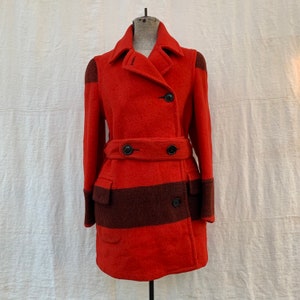A hunter dons the traditional point blanket capote in this painting "Following the Moose" by Cornelius Krieghoff, Brooklyn Museum, Wikipedia Commons
Point blankets originated, historically, as the heavy wool trade blankets that voyageurs and traders exchanged with the First Nations people for beaver pelts. The blankets were much in demand as they were waterproof as well as warm. In the 1700s, point blankets accounted for 60% of trade goods on the American continent. You’ve likely seen many pictures like this of native peoples enjoying the warmth such blankets offered.
Painting of an Indian woman by Anna Mariea Von Phul wikipedia commons
Point blankets were--and still are--stitched with lines 3-6 inches long on one edge that indicates their size. Hence, a 4-point blanket is larger than a 3-point blanket. There are also, less commonly, half-lines (2-3 inches) for those odd sizes in between, like a 3-1/2 point blanket. When folded up and shelved with the lines facing outward, it was easy to tell what size the blanket would be. Oh, that we had such a simple system for discerning between king, queen, and full-size sheets!Hudson Bay 4-Point Blanket, image from icollector.com
The Hudson Bay company originated the point blanket trade, and you can still find authentic Hudson Bay blankets today, recognized by the Hudson Bay emblem sewn into one corner. However, if they're of the old, collectible variety, they'll set you back hundreds if not thousands of dollars. Once the fur trade died out around the Great Lakes, the Hudson Bay company went on to develop other goods for sale, and today they are much like any catalog or online department store. You can find modern versions of the Hudson Bay point blankets--still spendy--and imitation versions from other companies as well.
If you are particularly canny with a sewing machine or needle, you can even make your own. There are many instructional videos, blogs, and pdfs online to guide you. Me...I'd like someone to make one for me. Here's my dream coat (found at TigerRagVintageNola on Etsy):
Maybe someday...
Do you happen to own a point blanket or even have an imitation tucked in a chest or covering the foot of your bed? What do you think of the style of the blanket capote? Is it something you could imagine yourself wearing?
Stay warm out there! It's only February! And Happy Valentines to all the Colonial Quills readers and writers!Naomi
Warm up inside with romance, adventure, and a glimpse into Lake Superior history.
Mist O'er the Voyageur and Song for the Hunter
Both on Kindle Unlimited as well as in paperback.






Thank you for sharing! I remember my paternal grandparents having Hudson Bay Blankets (They were born in 1901) when I was growing up in Minnesota! I noticed your use of the word "spendy!" Yes, I along w/ some of my adult children still say that word! :)
ReplyDeleteI bet you wish you had some of your grandma's blankets now! Yep...I'm old school--spendy. Haha!
DeleteWhat an interesting article. I didn't know about the Hudson Bay Blankets. This is the first I've heard about them. Thank you for writing this.
ReplyDeleteWell, cool! I'm glad you found it interesting!
DeleteI had read about the Hudson Bay blanket years before I actually saw one. My mother in law had one on each her 3 sons twin beds. We had my husbands for awhile but "someone" left it out in the garage and the mice got into it. It was ruined from both the chewing and the urine. It was difficult throwing it out. I loved the vibrant stripes on the cream background. I didn't know it was waterproof. I would love a coat made from one but I'm allergic to wool. Thanks for your article.
ReplyDeleteAw, such a shame! I can imagine how you felt. Yes--thinking about it now, I wonder if it would be more water resistant than waterproof. When I was a kid, my mom and dad and I always wore wool pants over our long-johns while deer hunting because they shed the snow.
DeleteThis is so interesting. I never knew a blanket could be waterproof but what a boon that must have been to those spending so much time outside in the elements. I've seen such a blanket but never owned one. Thank you for this article!
ReplyDeleteThinking on it now, I wonder if it would be better described as water resistant. As I mentioned to another commentor, wool pants while hunting in the winter time are great for shedding off the snow. It just doesn't absorb in. But even at that, say a blanket fell in the lake. Wrung out, I bet it would dry quickly, being wool.
DeleteThank you for sharing. Very interesting.
ReplyDeleteThanks for stopping by again, Lucy!
DeleteWhen I was in college, they still had a Hudson Bay company store in town and I would eye those beautiful blankets in the windows. Then one time I stopped and saw just how much they cost. I almost fainted. I always wanted one but I'm thinking that will never happen lol. They really are beautiful and how wonderful it is how practical they were, too. Many of our pictures in the Upper Peninsula of early times show people in those coats made from the blankets. I had never heard that they were waterproof either. I think as you said above, they were more water resistant. They were woven very tightly. But washable hence not waterproof. I thought I'd read somewhere that they could be treated with something that made them even more water resistant. Extra lanolin maybe?
ReplyDeleteHm! I wonder if they did use lanolin on some things like that--on moccasins too maybe. Just guessing around though. I have no idea. Just this week I saw that a younger friend of mine has a capote she wore in a snowshoeing/black powder shooting competition. It was beautiful! And she said it was super warm. I know what you mean about expensive! Eek!
Delete